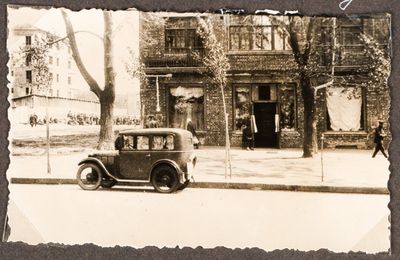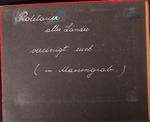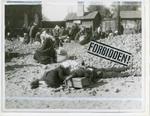Street view of a “Torgsin” store in Kharkiv, with a car parked in front
Description
- Creator
- Wienerberger, Alexander, 1891-1955, Photographer
- Media Type
- Image
- Text
- Item Types
- Photographs
- Photograph albums
- Description
- The photographer shows his BMW (which he had shipped from Germany for his use in the USSR), parked in front of what he identifies as a “Torgsin” shop. (from the Russian “Torgovlia s inostrantsami” or, Trade with Foreigners).
Luxurious curtains hang in the larger windows. The outer doors appear to be open, but not the inner door. A man –perhaps an attendant, sits near the entrance. Little activity is seen in the immediate vicinity. The long shadow cast by the tree indicates a sunny early morning or late afternoon. Around the corner and rather indistinctly visible is a very long, crowded line of people sitting and standing alongside a fence across the street. Based on published research, it is highly likely that they were waiting for the Torgsin shop to open or re-open for resident consumers, while foreigners had their own assigned hours for shopping. Note also the person peering into the car.
Context: Torgsin
The Soviet Torgsin stores were initially established exclusively for foreigners and the elite, where a full range of products could be purchased in hard currency. In 1931, the Politburo added many more shops of a much simpler variety and opened the Torgsin to Soviet citizens who could now trade in their family’s last valuables in exchange for a sack of flour or a loaf or two of bread.
In Ukraine, taking advantage of the desperation of a starving population, the number of shops grew from 74 in January 1933 to 249 in July,(Marochko, Torgsin, 4) mostly in the capitals of the worst stricken oblasts (states) of Kyiv and Kharkiv, and other oblast capitals to a lesser degree. As death rates from famine soared in 1933, so did Torgsin profits: of approximately 107 million rubles from the receipt of precious metals via Torgsin in the Soviet Union, two thirds came from Ukraine alone. Ukraine’s starving farmers, who were not permitted to have ration cards, often walked for miles and days to get to a Torgsin as a last resort. Now they would pay for the “bread” forcefully taken from them over the winter with their wedding bands and family heirlooms. For many, even that was not enough to survive.
For further information on: Availability and access to food in urban and industrial areas, see "Context Note" under Related Features at right.
- Notes
- Photo source: Wienerberger, Alexander. Das Arbeiterparadies. U.d.S.S.R. (also known as the Red Album). Unpublished and undated album in the private collection of Samara Pearce. p.18a.
For further details and a listing of originals and versions published through 1939 with their captions, see Related Features at right.
- Inscriptions
- Handwritten caption on page: “Geschäft für Ausländer; unser B.M.W. – Wagend davor.” [Shop for foreigners; daring to park our BMW in front]
- Date of Original
- spring-summer 1933
- Image Dimensions
-
Image Width: 8.1cm
Image Height: 5.5cm
- Subject(s)
- Personal Name(s)
- Wienerberger, Alexander
- Local identifier
- PD135
- Collection
- Alexander Wienerberger: Beyond the Innitzer album
- Language of Item
- German
- Geographic Coverage
-
-
Kharkiv, Ukraine
Latitude: 49.98081 Longitude: 36.25272
-
- Copyright Statement
- Copyright status unknown. Responsibility for determining the copyright status and any use rests exclusively with the user.
- Copyright Holder
- Samara Pearce https://www.samarapearce.com/
- Recommended Citation
- Wienerberger, Alexander. 1933. “Geschäft für Ausländer; unser B.M.W. – Wagend davor.” Das Arbeiterparadies. U.d.S.S.R. (also known as the Red Album). Private collection of Samara Pearce, n.d. p.18a. Retrieved from: http://vitacollections.ca/HREC-holodomorphotodirectory/3636331/data
- Location of Original
- Private collection of Samara Pearce. Please contact Ms. Pearce for reproductions from the original.
- Terms of Use
- Rightsholder requests that the name of the photographer, Alexander Wienerberger, accompany each authentic reproduction of his work.
- Reproduction Notes
- Reproduced with the permission of rightsholder Samara Pearce. Source: Private collection of Samara Pearce.




